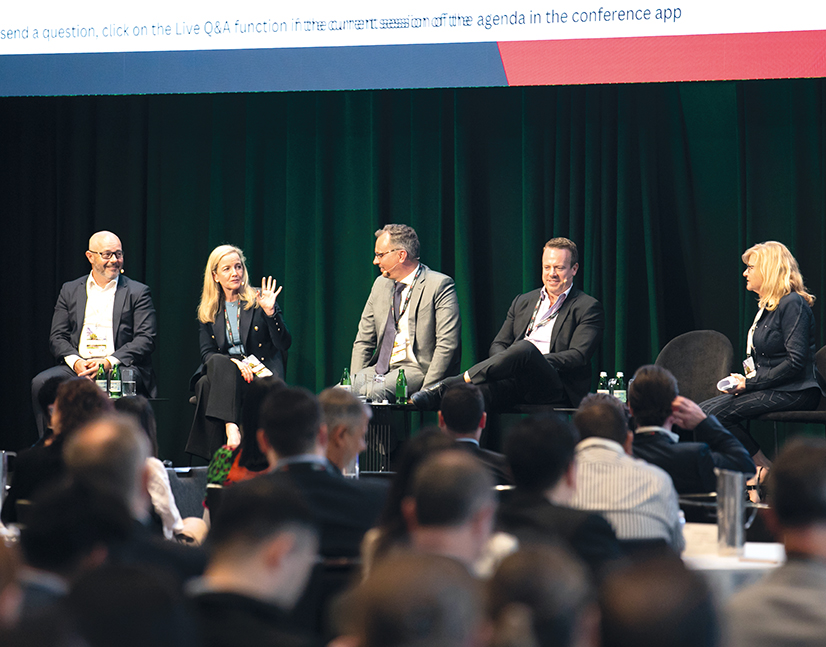
Digitalisation drives competitive edge across nonbank sector
Australia’s nonbank financial institutions are no strangers to the concept of chasing competitive advantage wherever they can find it. A roundtable hosted by KangaNews and Perpetual Corporate Trust explores ways in which digitalisation is delivering for nonbanks in the data, credit and funding spaces.
STREAMLINING SECURITISATION
Zaunmayr To what extent are digital processes already employed in issuers’ securitisation operations?
ZILELI We started the treasury transformation process last year and migrated from Excel spreadsheets to third-party software applications. It was quite an extensive process: we have moved two asset classes and are in the testing phase for moving our final asset class. We have been using the system for one year for the first asset class migrated and it has offered us a more streamlined process, greater control framework, scalability and improved analytics.
The expectation with the migration process was that everything would be digital, streamlined and improved. But now, with more hands-on experience, it is obviously just the beginning of the journey. More transformation and digitisation needs to take place to ensure the whole process is automated.
But it is certainly a good start. Moving to this system means many items – such as pool cuts, analysis and strat tables – are now quite straightforward, streamlined and capable of running different simulations of what a pool might look like.
Some of the biggest issues we have encountered so far are the specialist skill set and knowledge required to run the system – like owning a Lamborghini but only being able to go 40 kilometres an hour on the road.
The system can do much more and it is important to have multiple super users. The specialist skill set required needs to be front of mind as it will take new users some time to understand these systems, whereas everyone can drive an Excel spreadsheet.
We are at the start of the journey and have already made significant progress. To achieve end-to-end automation we need to address the remaining phases with small steps at a time. We have made the biggest step but there is still more we need to sort out to have a fully digitised process.
Some aspects remain out of our control, specifically industry progression to full digitisation. For example, using distributed ledger technology (DLT) to facilitate settlement would be nirvana but this is not something we can do alone. We can work toward it as an industry but it is further down the track for securitisation.
CARROLL Columbus Capital started on the journey of treasury automation about two years ago when we employed someone in treasury with IT and database skills. A lot of background, liability and other reports are automated, and we use a pool-selection tool to cut pools. Much of our warehouse selection is now semi-automated and all our warehouse reporting is automated.
We are part-way through the journey. The reduction of manual oversight means several processes, such as strat tables, are a lot easier. All monthly reporting on warehouses, term deals or pool cuts to rating agencies and investors are easily produced from our database.
It is not just treasury where technology is enhancing processes – we are looking at all back-office processes. Our recently introduced front-end system requires less manual processing, which results in increased data integrity and improved speed in customer decision-making.
We need to get data right, whether it is for investor reporting, rating agencies or for internal decision-making. The prime mortgage market is highly competitive so we need good data, fast decision-making and rapid customer responses to be competitive within the nonbank sector and against the major banks, some of which are further down the technology road.
From where we are now, we have the potential to bring in automatic credit decisioning down the track. This will mean faster processing times for credit decisioning, fewer manual processes and better overall outcomes for borrowers and our underwriting.
At present, we essentially have only one product – the residential-mortgage loan – which makes it easier for us to change processes. These things take time, even so. We are not sure where we will end up on this journey, but technology is at the forefront of our planning to get better and more accurate data, and better decision-making.
SICK BC Investment Group is in the fortunate position of being young – we are 4-5 years old. We were an outsourcer before we brought servicing and technology infrastructure in-house with two highly capable individuals. We made accessing timely and accurate information a focus early on – bringing technology in-house, building infrastructure capability and enabling the data warehouse to be the backbone of the business.
Technology is a key aspect of completing the end-to-end process efficiently, from capturing clients to performing credit assessment, and approving and settling the loan. We will never get rid of ‘warm bodies’, but the desired outcome will enable users to add value to the business rather than plugging data into spreadsheets every day for the rest of their natural life.
Automatic credit decisioning could also come into play as our balance sheet grows. We are looking at it but we are not quite there as it takes quite a long time to build out – at least a couple of years.
We have multiple warehouses and are heading toward a position where we are active in two countries and likely to build out into others. Having a complete view of the total balance sheet helps us make funding decisions, and understand liquidity and where risk lies – rather than having to trawl through dozens of spreadsheets.
Investors also like the idea of having a view of a facility and the underlying collateral through some type of technology platform, rather than waiting for a PDF report to drop into their mailbox or Bloomberg at the end of the month.
MCCARTHY Our goal is to enable the securitisation market digitally and create cloud solutions to bring it together from an end-to-end point of view, ensuring it is effective, efficient and scalable. At the same time, we are also focused on reducing risk, especially cyber-security risk.
We have an opportunity to delve into digital and cloud solutions to manage risk, as well as to maintain compliance with regulatory warehouse requirements in addition to deal and private deal requirements.
ELLWOOD Perpetual Digital focuses on innovation and digital solutions across the securitisation value chain, including warehouse optimisation, pool selection, the deal room, and investor and RBA reporting.
Internally, we are looking at a complete replacement and modernisation of our legacy payments and registry system that we use to process more than A$388 billion (US$287.7 billion) per annum of payments and distributions to noteholders, and which serves as the central registry for our residential mortgage-backed securities (RMBS) and asset-backed securities (ABS) portfolios.
We have a dedicated internal technology team working on the replacement and modernisation of our systems, and developing exciting digital solutions for our clients. The main objectives are to modernise our operating platforms and to provide an enhanced user experience. At the same time, the updated systems will provide scalability and efficiency, increase security and reduce the number of data touch points.
The other piece of work we are conducting is in the trust-management area. With the broadest range of asset classes, and one of the biggest books, we decided to develop our own cloud-based digital trust-management platform. It will provide scalability with enhanced transparency and real-time reporting.
The industry is rapidly moving from physical to electronic loan packets. We have launched a cloud-based, digital-custody platform to manage, store and process physical and electronic records. We are also now looking into how we can incorporate AI to streamline some manual tasks.
There is an increased spate of regulatory compliance for our lender-of-record clients so we are looking at ways to simplify and reduce the compliance burden. We are using our fiduciary intelligence digital platform, which is a user portal where lender-of-record clients can complete their regulatory and compliance reporting.
Cyber security focus intensifies
Cyber security is one of the most discussed, but least understood, aspects of modern financial markets. Getting to grips with it should be of critical concern to financial institutions of all stripes.
MCCARTHY Cyber security is ever more important, not just to us as businesses but also to our executives and board. It is a challenge for us as an industry to tighten security while improving the efficiency of the marketplace at the same time.
THORRINGTON With the increase in regulatory requirements – such as the Australian Prudential Regulation Authority’s Prudential Standard CPS 234 – our clients regularly require us to complete extensive security questionnaires. They want a high level of visibility across information-security practices. In response, organisations like ours conduct a number of assurance activities such as GS007 and ASAE 3150 control audits.
These allow clients to be confident in how systems are managed. If we could move other securitisation processes to digital solutions, the same kinds of benefits could be driven across the whole process, providing participants a real understanding of how risk and cyber security are managed.
Zaunmayr What progress has Westpac Institutional Bank made in its digital transformation journey? What are the bank’s primary goals?
KANARIS Securitisation has always been about data. Historically, the challenge has been how to collect data efficiently in a way that can be used to provide insights for our customers, and identify risks and opportunities for our business. Clearly, digitisation is a key part of the process.
Westpac has created a proprietary data warehouse called Odin, in partnership with Perpetual, which makes the whole process more seamless for us. We are also interested in Perpetual’s business-intelligence service, which will enable us to digitise portfolio data analytics and meet regulatory reporting requirements.
One of the common themes I come across when talking about digitisation is the ability to gain insight at the tip of a finger – this is what we are looking for. A great example right now is hardships. The ability to track data in real time, drill down into hotspots in very short order and provide risk insights is very important to our customers and our business.
Once we have rolled out and implemented Odin, we are optimistic it will deliver deeper insights and greater efficiency to our business. This will allow us to focus on what we do best: adding value to our customers.
Zaunmayr To what extent can an investment manager, like Realm Investment House, make its own progress in digitisation versus depending on issuers and arrangers to take steps on their side to simplify and enhance the investment process?
CAMILLERI Conformity and similarity of data is important – for instance having all issuers provide a standardised report pack. This has been achieved to some extent by the Reserve Bank of Australia (RBA) reporting template and has made aggregating data a whole lot easier.
We use a channel through Perpetual for cleaning data, which is then provided in a raw format. Perpetual also creates a lot of bespoke material for us, so we don’t have to build it in-house. Our key objective is to get data delivered to our platform in a specific form, so Perpetual acts as a go-between.
The way we do analysis has become very scalable. When a new deal comes out, we can have an answer within minutes about our view of credit enhancement, the way rating factors work and our own bespoke strat tables. Long gone are the days of getting a file with 5,000 loans that we have to slice and dice and then think about what we may have missed. We managed to systematise the process with great data feeds. This gives us a data advantage.
We use Matlab, which gives us speed. We also recently built internal codes for taking in data, doing rating overlays, and slicing and dicing before sending a number of reports out of the back end. These reports are interactive.
I can get a heat map of Australia with postcodes, LVRs [loan-to-value ratios], and income and property types, visualise it how I want and then drill down into the bubbles. I can look at the granularity of all the ‘dots’ to get a dimensional view of how risk is manifesting in a deal.
When I started in the industry, we were lucky to review a deal every quarter because it was just so burdensome. Every issuer had a different way of reporting the same fields. In a bespoke model, there were about 40 data-mapping tables. If anybody inserted a column it could break the whole system.
The big-data problem is a smaller challenge these days because we have streamlined feeds coming from issuers into firms like Perpetual, which systematise and aggregate data into databases we can access to feed our front-end systems.
COHEN Data-integrity issues raise questions about the whole credit-decisioning piece. Given the volume of transactions we look at, the ability to streamline and be efficient is very important.
We are probably slightly behind on the journey compared with Realm. IFM Investors has grown exponentially, which is now catching up to us in the way our system works – most of it is still Excel-driven. We have good data repositories, though, and macros feed in well.
We are working with Perpetual now on a similar type of solution to what Rob Camilleri describes at Realm. It is a smaller part of the asset-management system IFM is looking at, which feeds into everything from front- and middle-office reporting to investor reports and portfolio monitoring.
We have made great strides in this area since I started at IFM about four years ago, more out of necessity than anything else. We knew we needed faster and more accurate decision-making, as well as being able to feed these messages through to our own investors.
THORRINGTON A huge piece of innovation was the industry’s ability to adapt to the RBA’s data-reporting requirements. One key benefit of using a technology platform for this was it enabled users to have confidence about the risk and controls, and the security of the system, which are pen-tested and subject to an annual ASAE 3150 controls audit.
It has also proved to us that there is a huge benefit in moving away from Excel and toward platform-based solutions. It was a brilliant start and we continue to build on it each year.
WAREHOUSE SECURITISATION
Zaunmayr Going step-by-step through the securitisation lifecycle, starting at the warehouse stage, what are the key pain points and challenges for market participants?
ZILELI Looking back at the transformation we have already made, it is evident it will continue to be in stages. The data side is fine but we need improvements on notifications and payments. This includes creating effective payments and giving the required notices and obtaining consents – inward and outward – in a warehouse.
Another opportunity is a contacts and communications database. It makes sense to have an actively maintained database for investors and financiers that will automatically feed payments, forms and documents, built with the appropriate levels of authentication and safeguards to give everyone confidence.
We can develop this, but I suspect there is a huge overlap with what investors are doing. The data room Perpetual has created is a good start. It is not facilitating payments but it could be the start of a central database.
I like Perpetual’s Data Room and we are about to start using it. By giving investors specific access to different types of reports, all we need is a one-time set-up to determine what investors can access. We load the reports once, after which investors will all have access to the specific reports they require.
I wonder if there is something similar on the payment side – it would certainly be useful. Equally, there could be an opportunity to share data with end users, for instance rating agencies or investors, rather than sending huge files to everyone.
We can set up an easier way of file sharing, but it is more time consuming. These options exist on the warehouse side but they are not as streamlined as I would like them to be.
COHEN IFM is regularly the warehouse provider and occasionally we participate in term transactions. Both are essentially assets being transferred and, either way, we need to review samples and consents against parameters.
It can be a pretty manual process on the documentation side. It depends on how deals are set up but a lot are done through side letters – and this can become very time consuming. Communication and sharing data as early as possible is the most important thing from our perspective.
SICK It is an interesting point about having transaction counterparties as part of a library, so communication can be automated rather than manually sending emails.
We offered a large investor in one of our warehouses, that does not use Perpetual, access to the warehouse – enabling it to look at the data every day. This was very appealing, and it is one of the things we want to offer.
We are at the start of the journey of wiring into Perpetual’s technology platform and offering it to all our investors, and we are doing so because transparency helps with decision-making and keeping investors informed. We want to make it as seamless as possible.
The other important part is having internal capability to match any data set. We will lean quite heavily on the platform to manage our funding, warehouse positions and covenants.
It is equally important to provide this feedback to our sales channel, for example to inform them we are within 1-2 per cent of our interest-only cap. This allows us to slow down or control origination momentum – making it easier to manage the front-end sales channel and ensure compliance with our warehouse facilities.
CARROLL We are looking to add more technology in our treasury systems. One of the issues is we have multiple warehouses that all have their own eligibility criteria and portfolio parameters. These have to be met at individual warehouse level, for new-loan entry and on an ongoing basis.
There are systems out there, including one from Perpetual, which can manage asset selection into warehouses. We are currently managing this process on a semi-automated basis but additional technology could enhance the warehousing asset-selection process.
KANARIS The challenge for us on the warehouse funding side is the same one investors faced when there was no standardised set of reporting being offered similar to the RBA template. In warehouses, we get different styles of reporting from customers across different asset classes. When we are looking at options to run our analytic and business-intelligence tools, one of the key requirements is a standardised set of reporting for which the system can digest and analyse the data.
A key challenge is getting our customers onto a standardised data template that enables us to do more with the data. We have spent a fair bit of time on this, as most of the nonbanks in this group would attest.
But from a funder’s point of view – and speaking from Westpac’s perspective – this is one of the key challenges to obtaining the efficiency we are looking for.
CARROLL The issue here is that every bank has its own version of ‘standardised’ reporting. It would be more useful if we had an industry standard all funders and investors could use.
KANARIS I agree. A key aim of our Odin programme is to leverage the RBA reporting template as the basis for standardising our reporting. The challenge is the uniqueness of the information we may need from our customers relative to what is provided in the RBA template.
This is accentuated by the range of asset classes we fund and their bespoke reporting needs. Ultimately, standardisation is about finding the appropriate balance.
MCCARTHY Digital platforms enable the ingestion, standardisation and transformation of data to make it easily available and comparable. We will speak with warehouse banks about what a standard might look like, off the base of the RBA-mandated data standards for the market. The industry has put in a lot of effort and I don’t think we are getting the true benefits of this investment yet – but we can leverage off it.
Data standardisation to enable transparency for all parts of the ecosystem is important. It enables comparability, and it has to be positive if there are standard data sets for any asset class that deliver a better investor experience.
The evolution of digitalisation in securitisation is the creation of our new digital deal room, which can provide deal information securely. This can also help the issuer and lead manager provide a seamless and more efficient credit rating agency and investor experience in a controlled manner while taking the information they need securely.
We have not discussed payments, but another potential evolution would provide a single solution to enable free flow of information, whether it be consents, contacts or communications.
TERM DEALS
Zaunmayr Moving onto term deals, a place to start is the issuer’s initial pool cut prior to a transaction. What manual processes within this can be enhanced?
CARROLL Investors all want to see consistency in pool selection. Generally, investors take comfort from strat tables on the last deal looking much the same as the current one. They can then benchmark deal pricing against previous deals and relative to the market.
During my time at Columbus, I have done six RMBS transactions and there is significant commonality across all of them. Technology assists in the pool-selection process. An arranger bank assists with structuring, investor presentations and transaction admin. Columbus will cut the pool and provide it to the arranger, which liaises with the rating agencies. There may be a few questions from the rating agencies, but it is a relatively seamless process.
If we want to change the underlying pool or structure from a prior transaction, we discuss this with some core investors early on. If they do not have an issue, we expect the market will not either – and we can move ahead on this basis. The rest of the process has to date been relatively smooth. There is an intense period of workload but it is relatively straightforward.
SICK A bond is a mechanical process. Once we have done a few they all work in the same way. I certainly agree investors like consistency in portfolios. Of course they will still do credit work, but it is also possible to raise discussion points that may detract from the main objective.
I have cut a lot of pools in my time – unfortunately just using Excel – and it is a manageable process. But it becomes more complex as our balance sheet grows. It is great if we can lean on technology to ensure each pool looks the same as the last one, but to my mind more of the work is associated with the residual pool than the actual securitised assets.
Zaunmayr Latitude has migrated one of its portfolio assets and is looking to migrate others to the digital platform. Is there much difference between them at this point of the securitisation process?
ZILELI We have migrated two – the second one is in parallel test but it is in the new system. Public trades and pool cuts are now easy. The new technology gives us the ability to cut pools, check triggers on the remaining warehouse and run the strats on the new pool.
This has completely changed the process. It was a lot more cumbersome when everything was in Excel, as recently as 18 months ago. We had to download data and then run it via SQL queries to get pool strats, and only a few team members have the required specialist knowledge. It is now quite straightforward. The way we share data with third parties is not really a pain point in our term trades anymore.
Zaunmayr What could the ultimate streamlined public securitisation look like in the future?
ZILELI The ultimate in streamlined processing would be using DLT and enabling investors to put in orders, allowing us to see those orders, allocate them and finally facilitate settlement of the allocated orders.
Otherwise, the whole bookbuild process is still on spreadsheets. In the unsecured space, Commonwealth Bank of Australia did a transaction using DLT a couple of years ago but uptake does not seem to have gone very far.
Adopting this technology in the secured space would be a lot more complicated. If we are not there in the unsecured space, which should be quite straightforward, I cannot see our industry leading the way.
Zaunmayr What parts of the public securitisation space might be ripe for new ways of thinking from an arranger’s perspective?
KANARIS I think it is facilitating data distribution. As we have talked about, pool cuts are large file sizes and are typically sent to investors over email. A deal-room data warehouse that allows information to be distributed securely has a lot of benefits for the industry.
The ability to digest information relatively quickly and have investors rapidly analyse this information will hopefully make the marketing of public transactions a lot quicker.
Touching on the point about DLT, there are many promising benefits from an execution perspective. However, the issue for our market is ultimately the cost of implementing this technology. The focus in the near term will be extracting efficiency gains through quick wins rather than the big expensive builds – until the nexus of cost and scale can be overcome.
Lessons from, and divergence in, New Zealand
Navigating transaction-related information flow after primary-market issuance is a longstanding challenge in the OTC bond market. Technology could streamline the process and minimise errors and oversights.
ELLWOOD It has always been challenging to get communication through to underlying noteholders, especially where notes are held through nominee companies in Austraclear. If corporate actions, call dates or any sort of communication goes to a nominee company the issuer does not have certainty the communication or notice is being received by the underlying noteholder.
It could be beneficial to have an investor-communications portal where investors could use their ISIN number, log in and create their own portfolio watchlist and reporting platform. If anything happens, or the trustee wants to communicate something regarding a specific note, the information is uploaded and an alert pops up on the investor screen or an email is automatically sent.
Zaunmayr What do investors believe could be improved in the term-deal process?
COHEN We could look at a step before pool data. Ultimately, we are deciding upfront whether we go ahead and do credit work. We think about whether pricing will fall within our range and, as mezzanine investors, these tranches are naturally a little bit smaller. Demand is also sometimes stronger in this part of the structure so we think about whether we are going to get a worthwhile allocation to do the work.
We have talked about data quality and consistency, and in our opinion pool cuts are fine. What affects us at times is the process. This flows through to sub-pools, warehouses, parameters, consents, waivers and correlating items as well.
CAMILLERI We have built a fairly fast process to do deal assessment, in particular for public transactions. Speed is not so much a requirement in a warehouse transaction, once we have done all our upfront work.
But we allocate resources to deals that may go nowhere. Our overarching requirement is to build strong, transparent relationships with issuers that really understand our business and vice versa. Then we can participate meaningfully in transactions.
We were appointed to support the Australian Office of Financial Management in its credit-assessment process, and we knocked out something like 70 or 80 transactions in a couple of months. Most of these were from scratch – and we could not do this without having good data feeds and processes to produce in a timely manner.
MCCARTHY We are working on how to enable warehouse data that is consistent with pre- and post-deal data to ensure transparency and comparability across the entire deal process.
If we can match content through a data warehouse – with a deal room that can supply data and other components – we have simplified end-to-end data and deal flow with a strong communication and messaging system. It could be a real step toward improving the entire ecosystem.
THORRINGTON What we have seen in the last couple of years is participants really wanting to move off email. One key move we have undergone with our clients is to introduce alternate, secure ways of getting data to us to ensure – from a risk and cyber-security position – they are able securely to send and receive data and safeguard what is particularly important to them.
FUTURE DIRECTIONS
Zaunmayr What digital-innovation outcomes would market users like to see?
COHEN An incremental improvement to process and the way information flows through the market. Communication between participants is integral to this.
KANARIS Providing collateral data in a way that continues to be standardised, secure and transparent such that market participants can transact in a more efficient and timely manner.
SICK If there is some type of industry standard, with RBA reporting as a good example, it would make it easier for participants to make decisions. Consistent data should in theory allow easier engagement with investors, because everyone is provided with the same data sets.
From an issuer perspective, it would help us make informed decisions. Data quality helps us drive decisions about where we deploy capital, how we observe risk, how we cut a pool for investors and how we engage investors, whether this be in warehouse or bond phase.
ZILELI I have two points. The first – big – one is information sharing. The other is where we provide daily notifications for our warehouse when drawing down funding or sales notices.
Being able to streamline this process would be a great help, because it is cumbersome. We have to send letters to so many different organisations and people, and the way we are progressing it feels like a very antiquated process.
CARROLL If we can get more seamless processes we can improve efficiencies, eliminate errors and provide better data integrity, which are all better for investors.
Managing warehouse processes is more cumbersome than term deals, which are relatively smooth these days. If we could integrate more technology within the treasury function, particularly for data integrity, I think it would be better for all industry participants.
CAMILLERI We have come a very long way as an industry over the past 25 years. I can only imagine how innovative we are going to be over the next 25 years. I do not think I will be around – hopefully I will be happily retired by then! But we have solved the data question and now it is about systems – how we use the data and get the most out of it.
I would not say we have solved all our reporting problems, but we have solved our data-feeding issues and we are still sandboxing a lot of other issues. Most of the lingering questions are about systems. So even though we have built a good foundation across data and data feeding we still have a long way to go with how we visualise and render data to make better-informed decisions.
ELLWOOD A concern over the next few years is exposure on the security side. I agree that we have solved for data standardisation and we will solve and streamline a lot of the processes, but we should consider the security side of the data.
It is one of the reasons we are investing in technology, cyber risk and security measures – to ensure whatever processes we bring to market are offered in a safe and secure environment.
THORRINGTON It has taken so long for everybody to get up the curve on risk, and I think getting off email is something we need to sort out now to enable secure sharing of data.
MCCARTHY The fact that we have gone from where we were – taking three months to carry out a deal – to our current situation of being able to carry out a review in days or even hours, simply demonstrates the innovation we have seen over the last 25 years.
Our focus is to continue this innovation journey in our industry and leverage the digital capabilities available today to become more effective, efficient and economical, while improving cyber security and maintaining compliance. Our user-experience goals are for our new digital solutions to be as easy to use as the common spreadsheet and email but workflow-based and automated to drive efficiency and scalability.
Another goal is keeping the design of new operating products simple within a holistic cloud solution to deliver an end-to-end process rather than firing off a hundred emails with complex and myriad of formatted spreadsheets attached. Simple and effective is good.

nonbank Yearbook 2023
KangaNews's eighth annual guide to the business and funding trends in Australia's nonbank financial-institution sector.

WOMEN IN CAPITAL MARKETS Yearbook 2023
KangaNews's annual yearbook amplifying female voices in the Australian capital market.
















